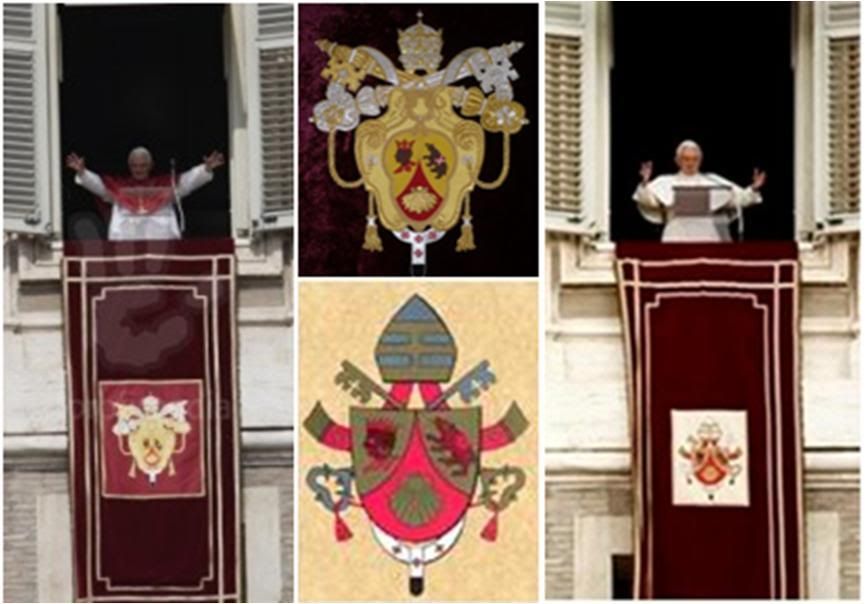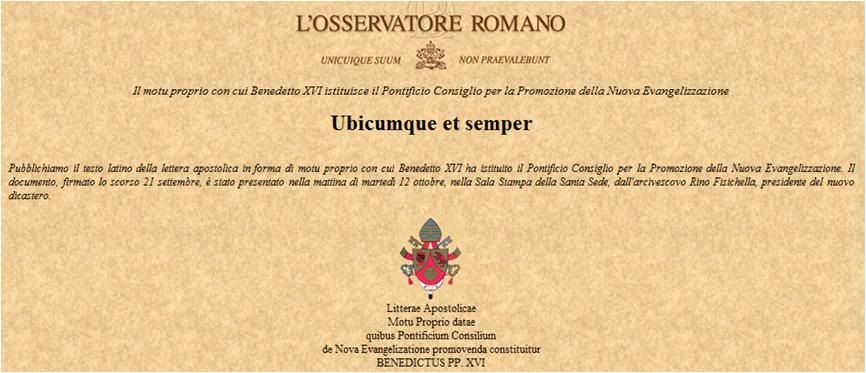| | | OFFLINE | | Post: 21.224
Post: 3.860 | Registrato il: 28/08/2005
Registrato il: 20/01/2009 | Administratore | Utente Master | |
|
Fretting about that
'new' coat of arms
A columnist in National Catholic Reporter blogs about the new papal coat of arms and enumerates quite a number of 'modifications' carried out on the design made by Cardinal Andrea Lanza di Montezomolo in 2005.
ncronline.org/blogs/ncr-today/has-pope-benedict-changed-his-c...
I'm still unhappy about the sudden change, if it is indeed a change, sprung on the public unannounced - surely the papal seal is no trivial matter and deserves a proper announcement and explanation from the Vatican, not a self-promoting press release by the person(s) apparently responsible for the redesign.... At least, so far, whenever Mons. Guido Marini is about to introduce some liturgical change, or new liturgical vestments, he announces it with explanations, which is the right way to do these things.
 In one commentary today, I read that according to Fr. Guy Sylvester, a New Jersey priest-blogger who is also a heraldry expert, the two seals can be used interchangeably depending on the occasion - i.e., when the miter might be appropriate, and when the tiara might be. But that's too confusing, and reflects an unbecoming ambivalence that, from what we know and what we read, has never afflicted Joseph Ratzinger/Benedict XVI.
In one commentary today, I read that according to Fr. Guy Sylvester, a New Jersey priest-blogger who is also a heraldry expert, the two seals can be used interchangeably depending on the occasion - i.e., when the miter might be appropriate, and when the tiara might be. But that's too confusing, and reflects an unbecoming ambivalence that, from what we know and what we read, has never afflicted Joseph Ratzinger/Benedict XVI.
I did find the following article - doubtless familiar to many - that was available on the USCCB website during the US visit, based on a 2005 OR article in which Cardinal Montezemolo explains his design, and I believe it is worth re-posting now. What he says about the miter replacing the three-tier tiara is particularly relevant.... P.S. The original longer aticle can be seen on the vatican site:
www.vatican.va/holy_father/benedict_xvi/elezione/stemma-benedict-xvi...
Pope Benedict XVI's
Coat of Arms
Pope Benedict revealed who he is in designing his papal coat of arms. He dispensed with the image of the three-tiered tiara that traditionally appeared at the top of each pope's coat of arms and replaced it with the pointed miter.
He also added the pallium, the woolen stole symbolizing a bishop's authority, to the elements surrounding the shield.
“Benedict XVI has chosen a coat of arms that is rich in symbolism and meaning, so as to put his personality and his papacy in the hands of history," said Italian Archbishop Andrea Cordero Lanza di Montezemolo, an expert on heraldry and creator of Benedict XVI's new insignia.
"For at least the past eight centuries, popes have had their own personal coats of arms in addition to the symbols of the Apostolic See," the archbishop said in the Vatican newspaper.
While each papal shield is unique, the elements surrounding it had more or less remained the same for centuries -- until now. Gone is the beehive-shaped crown whose actual use in important ceremonies was abandoned during the papacy of Paul VI.
For Pope Benedict's ensign, the more modest and recognizable miter has taken its place. But the silver miter has three gold stripes to mirror the symbolism of the papal tiara's three tiers: "order, jurisdiction and magisterium," said Archbishop Cordero Lanza di Montezemolo.
A vertical gold band connects the three stripes in the middle "to indicate their unity in the same person," he said.
The white pallium with black crosses draped below the shield “indicates the (bishop's) role of being pastor of the flock entrusted to him by Christ," wrote Archbishop Cordero Lanza di Montezemolo. [That was te only change indicated in the 'old' seal, actually - since the Pope decided to abandon the archaic long pallium (resurrected by Mons. Piero Marini for Benedict XVI's inaugural Mass) in favor of the modern-style pallium similar to what bishops wear. Except, of course, that the crosses on the papal pallium are red, not black. The shape of the pallium on the 'old' seal is the correct one, so only the color of the crosses ought to have been corrected.]
What has not changed and has been part of papal emblems for centuries is the Holy See's insignia of two crossed keys, which symbolize the powers Christ gave to the apostle Peter and his successors. The gold key on the right represents the power in heaven and the silver key on the left indicates the spiritual authority of the papacy on earth. The cord that unites the two keys alludes to the bond between the two powers.
Nestled on top of the keys lies the unique shield of Pope Benedict, which is based on his coat of arms as archbishop of Munich and Freising, Germany, and is particularly rich in personal and spiritual symbolism, wrote Archbishop Cordero Lanza di Montezemolo.
The shield is divided into three sections -- each of which has its own symbol. The central element on a red background is a large gold shell that has theological and spiritual significance for the Pope, the archbishop said.
The shell recalls a legend in which St. Augustine came across a boy on the seashore who was scooping water from the sea and pouring it into a small hole he had dug in the sand. When the saint pondered this seemingly futile activity, it struck him as analogous to limited human minds trying to understand the infinite mystery of the divine.
"The shell reminds me of my great master Augustine, of my theological work and of the vastness of the mystery which surpasses all our learning," wrote then-Cardinal Joseph Ratzinger in his 1997 memoir Milestones.
Archbishop Cordero di Montezemolo wrote that the shell has long symbolized the pilgrim, "a symbolism Benedict XVI wants to keep alive" after Pope John Paul II, "the great pilgrim."
The shell is also present in the coat of arms of the Schotten monastery in Regensburg, Germany, to which the Pope "feels very spiritually close," the archbishop said.
{And, relevant to the Pope's coming pilgrimage to Santiago de Compostela, it was the medieval pilgrimages to Compostela that turned the shell into the pilgrim's symbol.]
The upper left-hand section of the shield depicts a brown-faced Moor with red lips, crown and collar; it is a symbol of the former Diocese of Freising dating back to the eighth century. Though it is not known why the Moor came to represent Freising, in Milestones, the Pope said for him "it is an expression of the universality of the Church which knows no distinctions of race or class since all are one in Christ."
Finally, a brown bear loaded with a pack on his back lumbers up the upper right-hand section of the shield. The bear is tied to an old Bavarian legend about the first bishop and patron saint of the Diocese of Freising, St. Corbinian. According to the legend, when the saint was on his way to Rome, a bear attacked and killed his horse.
St. Corbinian punished the bear by making him carry the saint's belongings the rest of the way to Rome. Archbishop Cordero Lanza di Montezemolo said the bear symbolizes the beast "tamed by the grace of God," and the pack he is carrying symbolizes "the weight of the episcopate."
The Pope said ended his 1997 memoir with the words: “I have carried my pack to Rome and wander for some time now through the streets of the Eternal City. When release will come I cannot know. What I do know is that I am God's pack animal, and, as such, close to him."
- Excerpted from the book “From Pope John Paul II to Benedict XVI.” Copyright © 2005 United States Conference of Catholic Bishops.
I realize this may all be futile argumentation on my part against what may be a fait accompli, but my greatest objection to the new design is the restitution of the tiara. I had never thought about this subject before, but now I am revved up.
Pietro Siffi has argued that the tiara has 'always' been a 'traditional component' of any papal seal. Surely, that 'always' goes back at best to the medieval era and not to St. Peter's time. [See all the Popes' personal emblems since Innocent III in 1198 on en.wikipedia.org/wiki/Papal_coat_of_arms] NB: The 'new' design for B16 looks particularly flamboyant compared to all the rest!
There is nothing at all in Jesus's messages to Peter about his role in the Church that implied kingship in any way! Peter was to be a fisher of men and shepherd of his flock, not king or ruler of anything! In fact, Benedict XVI said it best on April 19, 2005 - he is 'a humble and simple worker in the vineyard of the Lord'. How does one go from that to kingship?
It might be argued that the crown stands for the kingship of Christ, but that is also a worldly spin. The best symbol for Christ is the Cross, and indeed, a small cross on a globe surmounts the papal tiara, and generally the cross makes up one of the decorative motifs for the individual crowns. But the cross is easily subsumed in the prominence of that triple beehive crown.
Apparently the first papal crown was a simple circlet similar to a prince's crown to signify temporal power. Then one Pope added a second layer to show spiritual dominion. Yet another Pope added the third crown to signify that papal authority was superior to civilian authority. Hardly edifying spiritual gestures!
Of coure, having three layers facilitated any number of other interpretations based on famous 'triple elements' associated with the Church and its role in the world, and even with Christ's threefold role as Priest, Prophet and King.
But this is all arbitrary - wheraas the obvious symbolism of a tiara as showy as a triple crown is necessarily temporal power. When Italy took over the Papal States in 1860, that effectively ended the temporal power of the Popes. The tiara should have been dropped from the papal seal after that! Or simplified, as Cardinal Montezemolo did creatively.
I also see that the formula pronounced when a Pope was crowned translates to: "Receive the tiara adorned with three crowns and know that thou art Father of princes and kings, Ruler of the world, Vicar of our Saviour Jesus Christ." 'Ruler of the world'???? And no Pope had any trouble with that formula????
I can understand that the tiara has stayed on the seal of the Holy See and the related seal of Vatican City. Rightly so, because the temporal power of the Popes was a considerable part of the history of the papacy and of the Holy See.
But it is surprising no one ever thought to incorporate Christ's Crown of Thorns into the papal tiara design - then it might be more meaningful. Being Pope is so much more a sorrowful responsibility than it is glorious! (The glory, after all, is God's not the Pope's.)
P.S. Should we read anything into the fact that in tomorrow's OR (10/13), the heading for the new Motu Proprio still uses the 'old' stemma papale? [All my fingers and toes are crossed!]
 Or maybe it's just the Vatican being behind as usual on certain things.
Or maybe it's just the Vatican being behind as usual on certain things.
[Modificato da TERESA BENEDETTA 14/10/2010 21:12] |